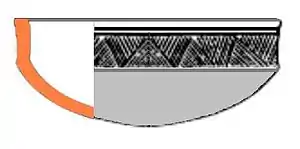Unstan Ware
Die Unstan Ware bezeichnet eine neolithische Töpferware, die ab dem Ende des 4. Jahrtausends v. Chr. in Schottland angefertigt wurde.

Definition
Die Keramiktradition wurde von Stuart Piggott (1910–1996) auf Grund von Funden aus den Stalled Cairns auf den Orkney[1] definiert und nach 35 Schüsseln benannt, die im Unstan Cairn auf Orkney-Mainland gefunden wurden.
St. Piggot versteht unter Unstan-Ware unverzierte rundbodige Schalen mit geradem oder eingezogenem Rand und Schalen mit Umbruch und einer gerieften oder gestochenen bandförmigen Verzierung zwischen Umbruch und Rand. Audrey Henshall verengte die Definition auf verzierte Schalen mit Umbruch[2] Piggots erster Typ wird heute meist als “Plain bowls” bezeichnet.
Merkmale
Die Unstan-Keramik ist durch eine einzige Form charakterisiert: eine breite rundbodige Schale, die meist zweigeteilt ist. Ihre senkrechte oder leicht konische Schulter ist manchmal durch einen leichten Wulst vom Gefäßkörper abgehoben. Nur die obere Gefäßhälfte ist verziert. Die Muster, Linien, seltener Dreiecke oder gefüllte Winkelbänder sind gestochen, geritzt und gestochen. Daneben kommen unverzierte Gefäße vor.
Verbreitung
Unstan-Ware wurde nur im nördlichen und nordwestlichen Schottland gefunden, auf den Orkney im Knap of Howar, in Stonehall und im Midhowe Cairn, auf dem Calf of Eday, im Wideford Hill Cairn, auf den Hebriden im Crannóg von Eilean Domhnuill im Loch Olabhat/Loch Olivat und Eilean an Tighe[3] auf North Uist, und Northton auf Harris[4].
Auf dem schottischen Festland gab es Funde in Skitton, Caithness und Urquhart, in Moray, Kenny’s Cairn in Caithness und im Ord North[5] in Sutherland. Die Verzierung neolithischer Gefäße aus Balbridie[6][7] zeigt gewissen Ähnlichkeiten zur Unstan-Keramik, die Form ist jedoch deutlich anders.
Bestattungen
Unstan-Töpferwaren wurden gehäuft in den langgestreckte Ganggräbern der „Stalled cairns“ des Typs Orkney-Cromarty entdeckt.
Datierung
Die Blütezeit der Unstan-Keramik ist nach Alison Sheridan[8] zwischen 3600/3500 BC (Knap of Howar) und 3200 anzusetzen.
Die Unstan-Töpfertradition wird auf den Orkneys durch die Grooved-Keramik abgelöst, die in Skara Brae und Maes Howe, aber auch auf dem Britischen Festland vertreten ist.
Siehe auch
- Prähistorische Keramik in Großbritannien
Literatur
- Ian Armit: Scotland’s hidden history. Tempus, Stroud 1998, ISBN 0-7524-1400-3.
- Trevor Garnham: Lines on the landscape, circles from the Sky. Monuments of Neolithic Orkney. Stroud, Tempus 2004, ISBN 0-7524-3114-5.
- John W. Hedges: Tomb of the eagles. A window on Stone Age tribal Britain. London, Murray 1984, ISBN 0-7195-4343-6.
- Audrey Shore Henshall: The chambered Tombs of Scotland. Band 2. Edinburgh University Press, Edinburgh 1972, ISBN 0-85224-190-9.
- Stuart Piggott: Scotland before history. Edinburgh University Press, Edinburgh 1982, ISBN 0-85224-348-0.
- Gordon Thomson: The other Orkney book. Northabout Publishing, Edinburgh 1980, ISBN 0-907200-00-1.
- Alison Sheridan: French connections I: spreading the ‚marmites‘ thinly. In: Ian Armit, Eileen M. Murphy, Eimear Nelis, Derek Simpson (Hrsg.): Neolithic settlement in Ireland and Western Britain. Oxbow, Oxford 2003, ISBN 1-8421-7091-0, S. 2–17.
Einzelnachweise
- Stuart Piggott: The Neolithic Cultures of the British Isles. Cambridge University Press, Cambridge 1954, S. 248.
- Niall M. Sharpies: The excavation of a chambered cairn, the Ord North, at Lairg, Sutherland by J X W P Corcoran. In: Proceedings of the Society of Antiquaries of Scotland. Bd. 111, 1981, S. 21–62, hier S. 38, (Digitalisat (PDF; 4,36 MB)).
- W. Lindsay Scott: Eilean an Tighe: A pottery workshop of the second Millennium B.C. In: Proceedings of the Society of Antiquaries of Scotland. Bd. 85, 1950/1951, S. 1–37, (Digitalisat (PDF; 19 MB)).
- Derek D. A. Simpson: The Later Neolithic and Beaker settlement at Northton, Isle of Harris. In: Colin Burgess, Roger Miket (Hrsg.): Settlement and Economy in the Third and Second Millennia B.C. Papers delivered at a Conference organised by the Department of Adult Education, University of Newcastle upon Tyne, January 1976 (= British Archaeological Reports. 33). British Archaeological Reports, Oxford 1976, ISBN 0-904531-52-X, S. 221–231.
- Niall M. Sharpies: The excavation of a chambered cairn, the Ord North, at Lairg, Sutherland by J X W P Corcoran. In: Proceedings of the Society of Antiquaries of Scotland. Bd. 111, 1981, S. 21–62, hier S. 34, 38, (Digitalisat (PDF; 4,36 MB)).
- Alan D. Fairweather, Ian B. M. Ralston: The Neolithic timber hall at Balbridie, Grampian Region, Scotland: the building, the date, the plant macrofossils. In: Antiquity. Bd. 67, Nr. 255, 1993, S. 313–323, hier S. 315, doi:10.1017/S0003598X00045373.
- Ian B. M. Ralston: A timber hall at Balbridie Farm: The Neolithic Settlement of North East Scotland. In: Aberdeen University Review. 168, 1982, S. 238–249.
- Alison Sheridan: French connections I: spreading the ‚marmites‘ thinly. In: Ian Armit et al. (Hrsg.): Neolitic settlement in Ireland and Western Britain. Oxbow, Oxford 2003, S. 2–17.